Thermal Softening Measurements of Refractory High-Entropy Alloys
Abstract
:1. Introduction
2. Experimental
3. Results and Discussion
3.1. Measurement of Thermal Expansion and Related Thermal Transitions

3.2. Measurement of Rockwell-Type Hardness as a Softening Meter
- (1)
- First, applying the so called “traditional” method, we measure the displacement curves (D) for different loads (see Figure 6a). In the spirit of Rockwell-type hardness measurement, we determine the indentation depth (ID) by subtracting two displacement data: those obtained with the larger load (1 and 3 kg) from those obtained with the small one (0.5 kg). The increasing ID is transformed in decreasing HR by simple subtraction of ID from an arbitrarily chosen value (300) (see Equation (9)):
- -
- The softening temperature (Ts = 950 K) is assessed to the “knee” point of the HR(T) curve (see Figure 6b). This hot–red point is visible, displacing to smaller values with increasing load. The optimal load should be chosen as a function of the initial, low-temperature hardness, taking into account that the larger the load, the more difficult it is to perform the measurement.
- (2)
- For rapid measurements, we propose the following protocol:
- -
- Taking into account that the thermal expansion coefficient, TEC, has a small and negligible increase with temperature, we take as an average TEC the low temperature value and construct in Figure 7, the thermal expansion line (see Figure 7a). The indentation depth (ID) is obtained by subtracting the measured displacement (D) curve from the thermal the expansion line (TEL):

4. Conclusions
- Measurement with commercialized equipment is equivalent with a heat treatment which may influence the validity of high-temperature measurements. Here, we present a relative rapid measurement, reaching the maximum temperature (1100 °C) within half an hour.
- Due to the high heating rate, all the nonequilibrium alloys (amorphous, over-saturated solid solutions, like HEAs) can be studied in their “as received” state, suppressing or eliminating the time-dependent diffusional effects.
- A detailed measurement protocol was presented to facilitate the determination and evaluation of high-temperature hardness measurement.
- The presented device serves as a dilatometer as well, applying the necessary corrections for the dilatation of a quartz tube and tungsten indenter.
- The presented device is an order of magnitude cheaper than those commercially available.
- The presented device is easy to build in even a moderately equipped lab.
- A new formula was presented, permitting researchers to fit the experimental results within the whole temperature range.
Author Contributions
Funding
Institutional Review Board Statement
Informed Consent Statement
Data Availability Statement
Acknowledgments
Conflicts of Interest
References
- Li, W.; Kou, H.; Zhang, X.; Ma, J.; Li, Y.; Geng, P.; Wu, X.; Chen, L.; Fang, D. Temperature-dependent elastic modulus model for metallic bulk materials. Mech. Mater. 2019, 139, 103194. [Google Scholar] [CrossRef]
- Zakarian, D.; Khachatrian, A.; Firstov, S. Universal temperature dependence of Young’s modulus. Met. Powder Rep. 2019, 74, 204–206. [Google Scholar] [CrossRef]
- Laplanche, G.; Gadaud, P.; Perrière, L.; Guillot, I.; Couzinié, J.P. Temperature dependence of elastic moduli in a refractory HfNbTaTiZr high-entropy alloy. J. Alloys Compd. 2019, 799, 538–545. [Google Scholar] [CrossRef]
- Born, M.; Huang, K. Dynamical Theory of Crystal Lattices; Oxford U.P.: Oxford, UK, 1954. [Google Scholar]
- Wu, Z.; Bei, H.; Pharr, G.M.; George, E.P. Temperature dependence of the mechanical properties of equiatomic solid solution alloys with face-centered cubic crystal structures. Acta Mater. 2014, 81, 428–441. [Google Scholar] [CrossRef]
- Dietze, H.-D. Die Temperaturabhängigkeit der Versetzungsstruktur. Eur. Phys. J. A 1952, 132, 107–110. [Google Scholar] [CrossRef]
- Nabarro, F.R.N. Fifty-year study of the Peierls-Nabarro stress. Mater. Sci. Eng. A 1997, 234, 67–76. [Google Scholar] [CrossRef]
- Li, W.; Zhang, X.; Kou, H.; Wang, R.; Fang, D. Theoretical prediction of temperature dependent yield strength for metallic materials. Int. J. Mech. Sci. 2016, 105, 273–278. [Google Scholar] [CrossRef]
- Pavlina, E.J.; Van Tyne, C.J. Correlation of Yield Strength and Tensile Strength, with Hardness for Steels. J. Mater. Eng. Perform. 2008, 17, 888–893. [Google Scholar] [CrossRef]
- Bhatt, V.P.; Desai, C.F. Temperature dependence of Vickers microhardness and creep of InBi single crystals. Bull. Mater. Sci. 1982, 4, 23–28. (In India) [Google Scholar] [CrossRef]
- Hsu, C.Y. Correlation of hot-microhardness with elevated temperature-tensile properties of low activation ferritic steel. J. Nucl. Mater. 1986, 141, 518–522. [Google Scholar] [CrossRef]
- Rajan, K.; Sarma, V.S.; Kutty, T.R.G.; Murty, B.S. Hot hardness behaviour of ultrafine grained ferritic oxide dispersion strengthened alloys prepared by mechanical alloying and spark plasma sintering. Mater. Sci. Eng. A 2012, 558, 492–496. [Google Scholar] [CrossRef]
- Westbrook, J.H. Temperature dependence of the hardness of secondary phases common in turbine bucket alloys. JOM 1957, 9, 898–904. [Google Scholar] [CrossRef]
- Merchant, H.D.; Murty, G.S.; Bahadur, S.N.; Dwivedi, L.T.; Mehrotra, Y. Hardness-temperature relationships in metals. J. Mater. Sci. 1973, 8, 437–442. [Google Scholar] [CrossRef]
- Sherby, O.D.; Armstrong, P.E. Prediction of activation energies for creep and self-diffusion from hot hardness data. Met. Trans. 1971, 2, 3479–3484. [Google Scholar] [CrossRef]
- Magazzù, A.; Marcuello, C. Investigation of Soft Matter Nanomechanics by Atomic Force Microscopy and Optical Tweezers: A Comprehensive Review. Nanomaterials 2023, 13, 963. [Google Scholar] [CrossRef] [PubMed]


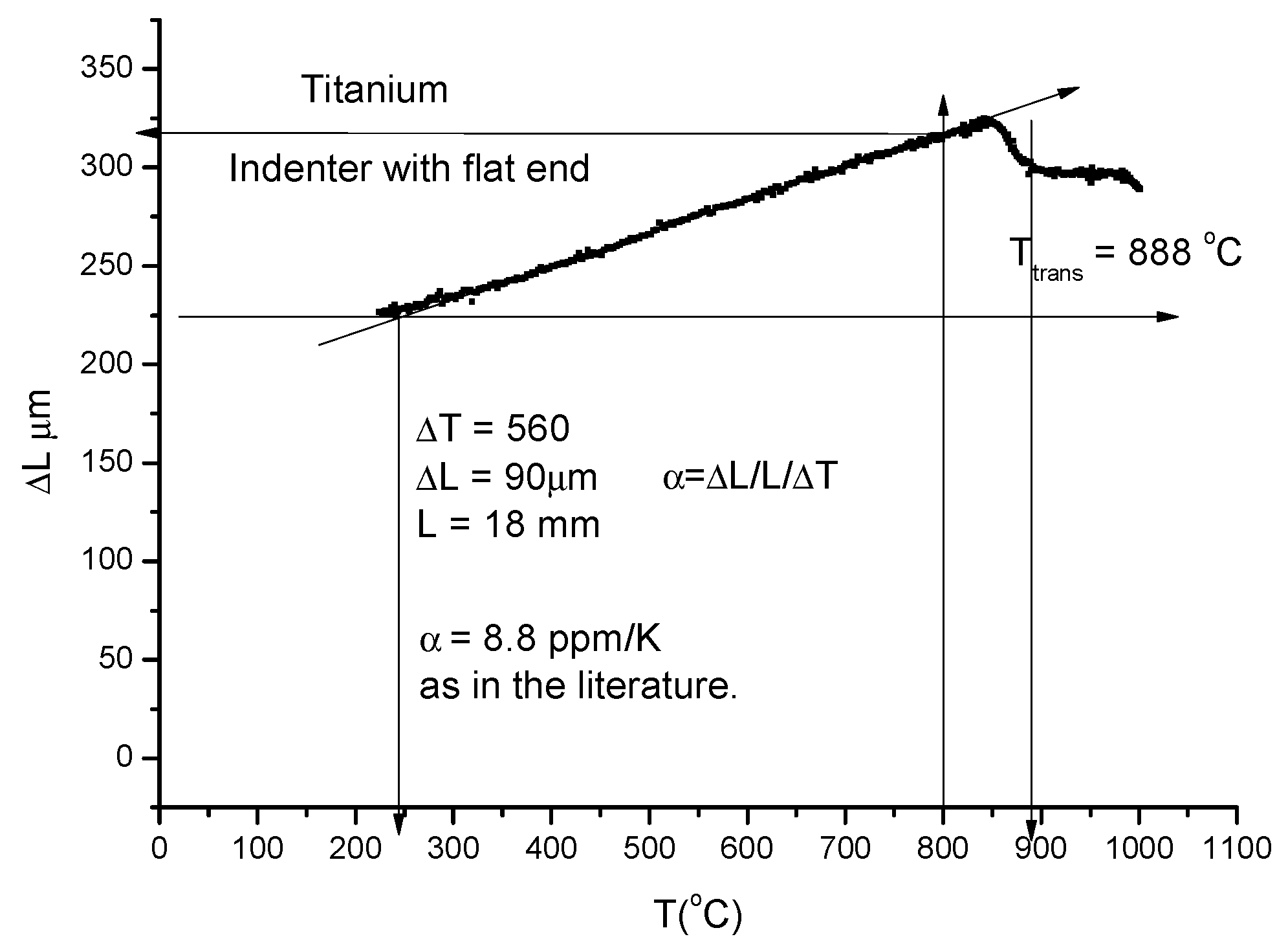
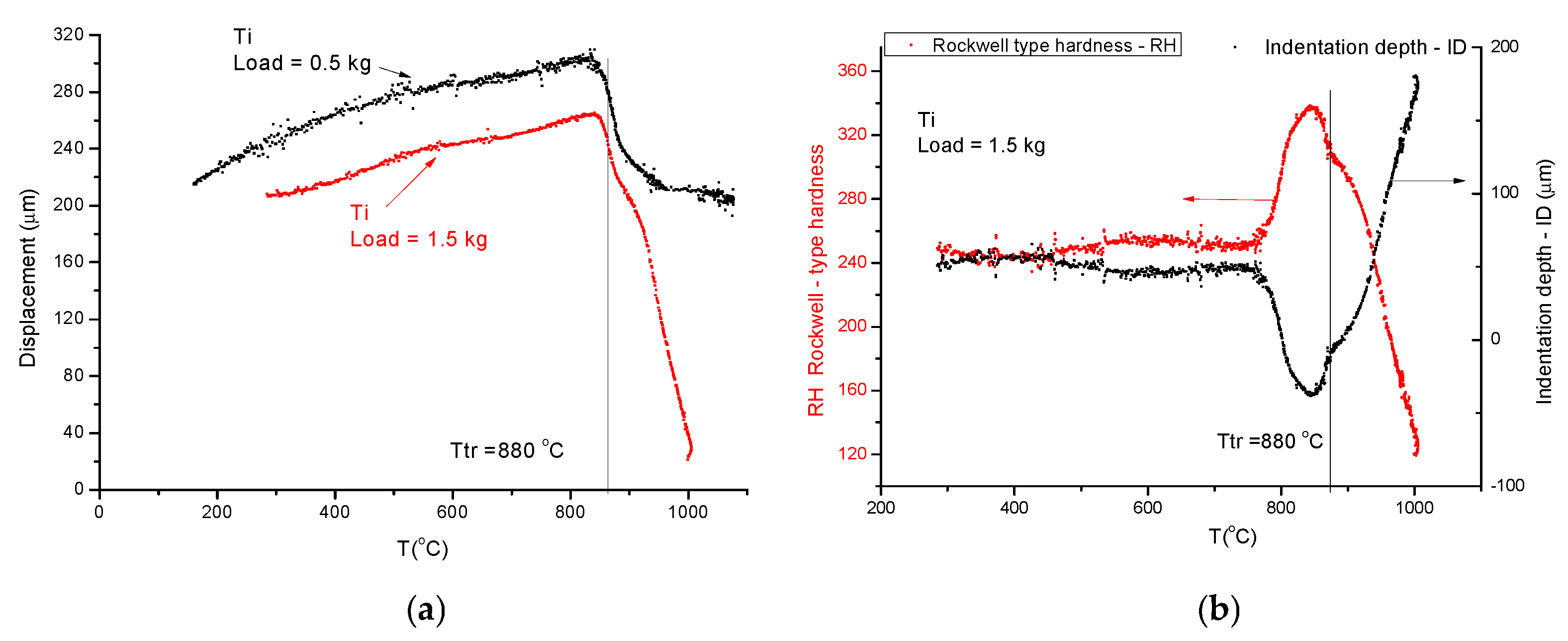
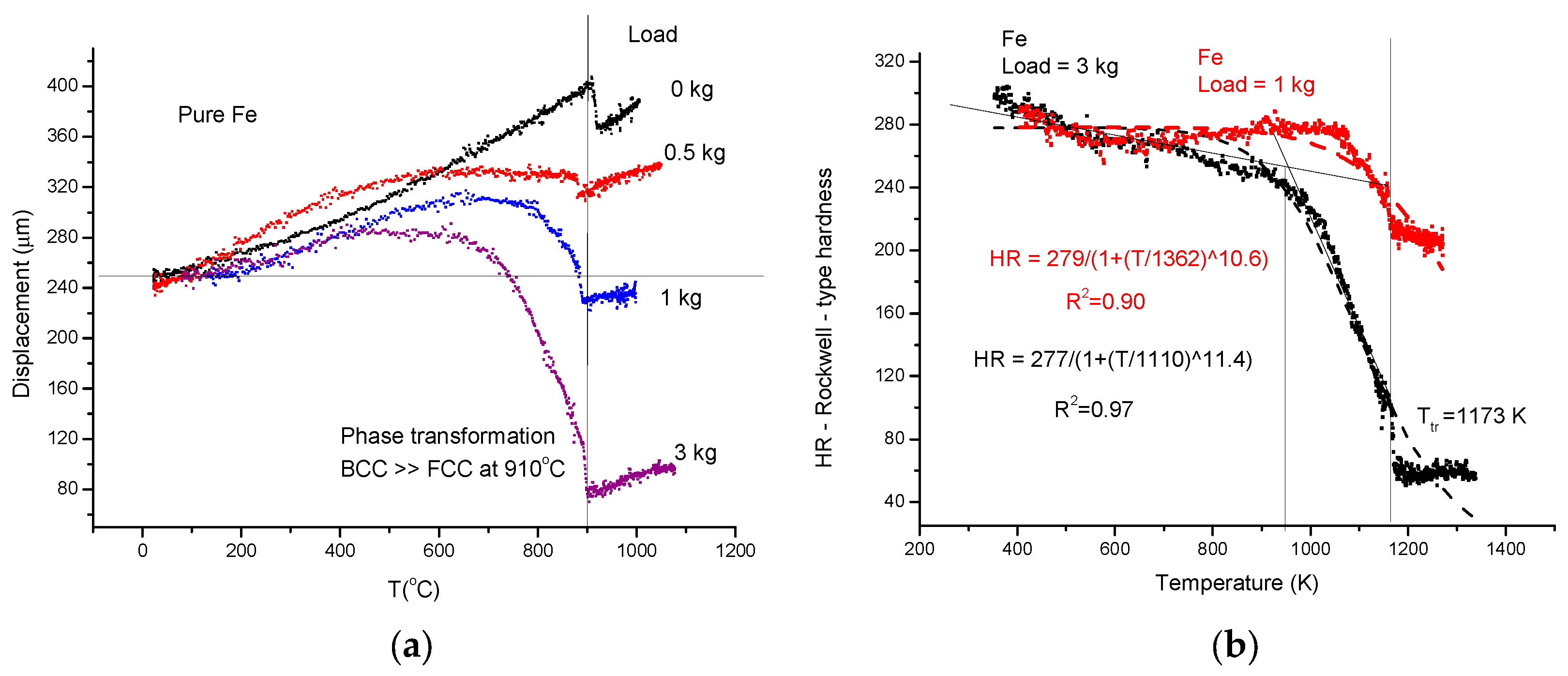
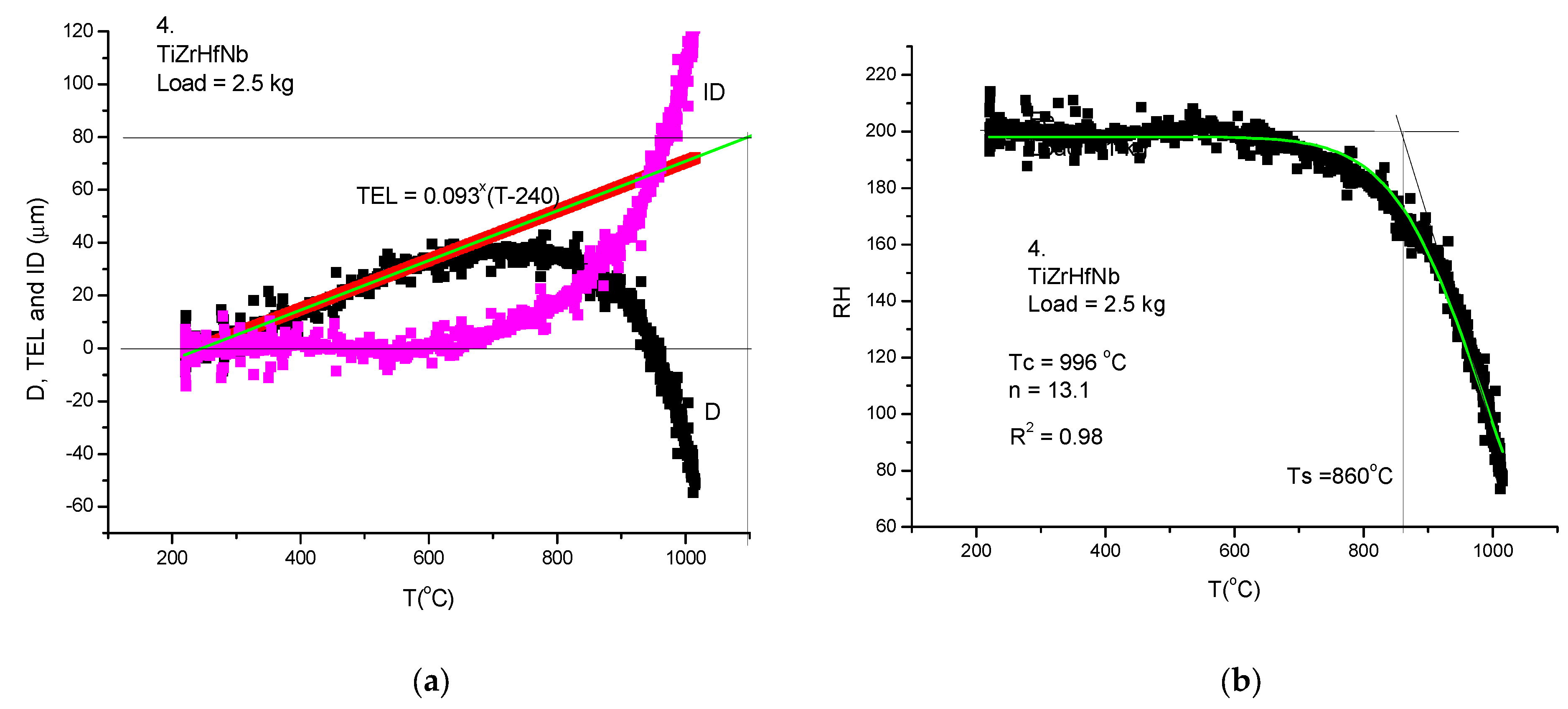
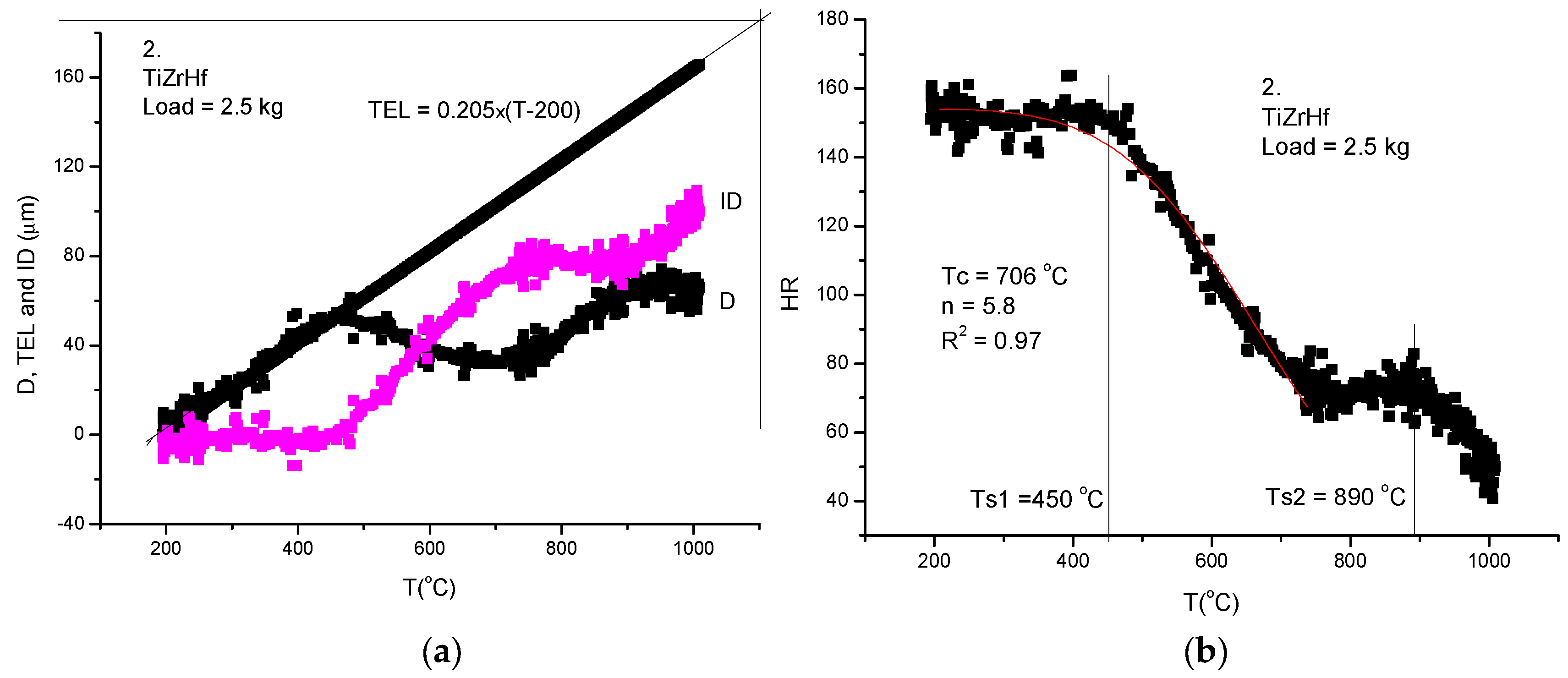
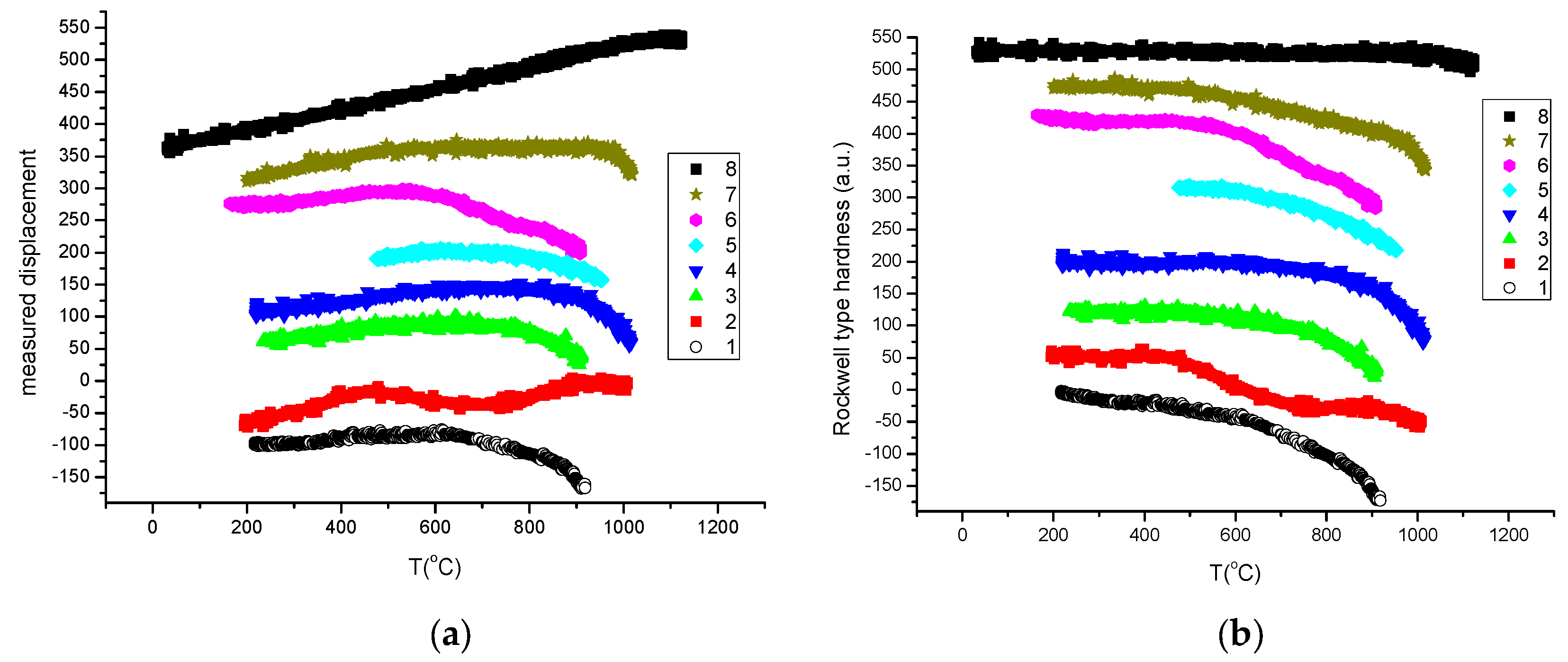

| RHEA | a (Angstrom) | VEC | HV (kgf/mm2) | Ts (°C) | Tc (°C) | n | |
|---|---|---|---|---|---|---|---|
| 1 | Y25Ti25Zr25Hf25 | 3.57702 | 3.75 | 271.3 | 610 | 823 | 5.53 |
| 2 | Ti33.33Zr33.33Hf33.34 | 3.47057 | 4 | 310.16 | Ts1 = 450 Ts2 = 890 | 706 | 5.8 |
| 3 | Ti30Zr30Hf30Nb10 | 3.45071 | 4.1 | 336.46 | 722 | 803 | 11 |
| 4 | Ti25Zr25Hf25Nb25 | 3.42335 | 4.24 | 336.21 | 860 | 996 | 13.1 |
| 5 | Ti25Zr25Hf25Nb25 | 3.42335 | 4.4 | 415.19 | 744 | 830 | 10.8 |
| 6 | Ti25Zr25V25Nb25 | 3.29035 | 4.5 | 381.16 | 520 | 758 | 8 |
| 7 | Ti20Zr20V20Nb20Ta20 | 3.30111 | 4.6 | 398.71 | 1000 | 1004 | 4.91 |
| 8 | V25Nb25Mo25W25 | 3.17187 | 5.5 | 432.24 | 1000 | 1250 | 12.5 |
Disclaimer/Publisher’s Note: The statements, opinions and data contained in all publications are solely those of the individual author(s) and contributor(s) and not of MDPI and/or the editor(s). MDPI and/or the editor(s) disclaim responsibility for any injury to people or property resulting from any ideas, methods, instructions or products referred to in the content. |
© 2024 by the authors. Licensee MDPI, Basel, Switzerland. This article is an open access article distributed under the terms and conditions of the Creative Commons Attribution (CC BY) license (https://creativecommons.org/licenses/by/4.0/).
Share and Cite
Temesi, O.K.; Karacs, A.; Chinh, N.Q.; Varga, L.K. Thermal Softening Measurements of Refractory High-Entropy Alloys. Materials 2024, 17, 5718. https://doi.org/10.3390/ma17235718
Temesi OK, Karacs A, Chinh NQ, Varga LK. Thermal Softening Measurements of Refractory High-Entropy Alloys. Materials. 2024; 17(23):5718. https://doi.org/10.3390/ma17235718
Chicago/Turabian StyleTemesi, Ottó K., Albert Karacs, Nguyen Q. Chinh, and Lajos K. Varga. 2024. "Thermal Softening Measurements of Refractory High-Entropy Alloys" Materials 17, no. 23: 5718. https://doi.org/10.3390/ma17235718
APA StyleTemesi, O. K., Karacs, A., Chinh, N. Q., & Varga, L. K. (2024). Thermal Softening Measurements of Refractory High-Entropy Alloys. Materials, 17(23), 5718. https://doi.org/10.3390/ma17235718






